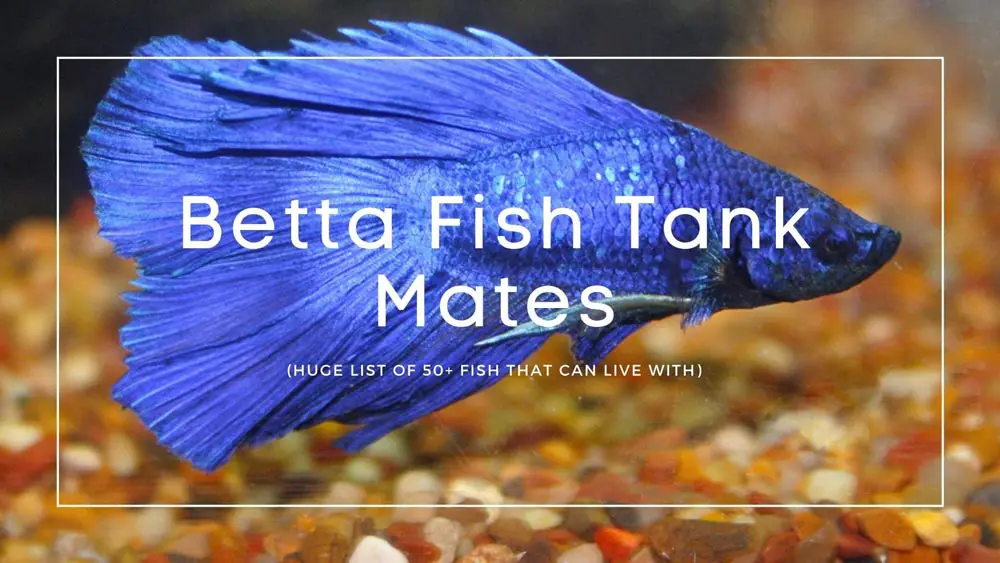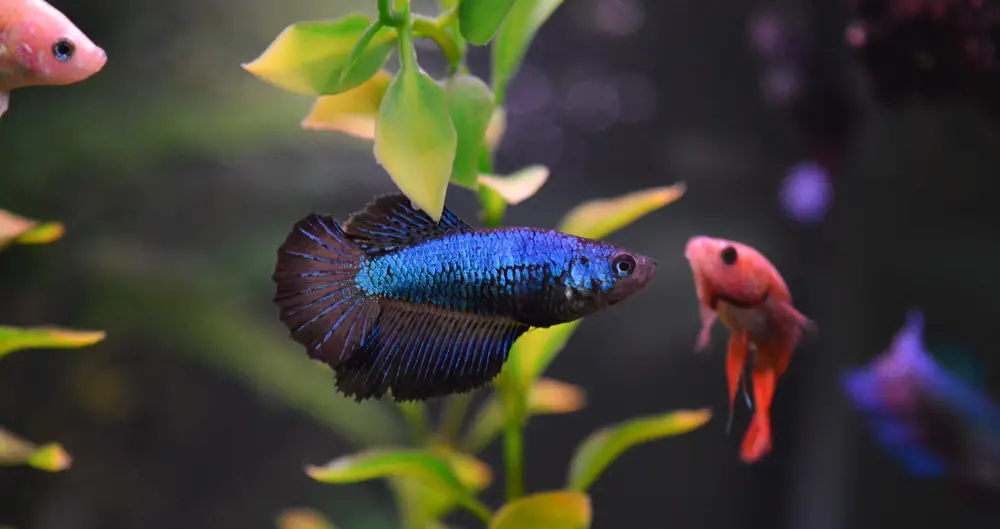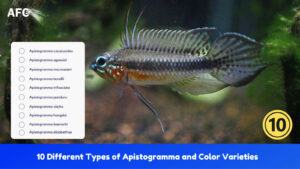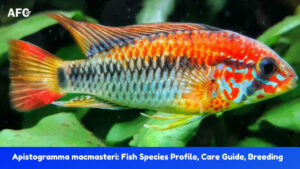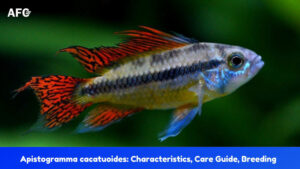Are you looking to set up a community tank full of a variety of colorful and strikingly exciting fish? Bettas are the perfect eye candy for your community tank. Their colors are vibrant, and their finnage is flamboyant.
However, Bettas have a terrible reputation for being aggressive and territorial fish. This can make finding compatible tankmates for your Betta difficult. In general, Bettas are perfectly happy by themselves. But if you want a community aquarium with Bettas, we have the best advice for you today.
Betta Fish Tank Mates Overview
In their natural habitat in the wild, bettas can live among other bettas peacefully. They only show aggression when a male Betta feels his territory is being threatened by another male Betta, as well as during the breeding season.
However, their temperament becomes more aggressive when placed in captivity and aquariums. Stressful environments and selective breeding are the leading cause of this aggressive behavior.
When choosing tankmates for your Bettas, you should choose a peaceful fish. They should be a shoaling and fast swimming species, as well. You do not want to pick fish that have a reputation for nipping other fish’s fins. Bottom-dwelling fish work well because they tend to stay away from the Betta’s territory.
Tetras are perfect tankmates for your Betta. They are a shoaling species and are generally peaceful. They are smaller than Bettas, only growing to around one or two inches, depending on the particular species. Here is a shortlist of compatible Tetras:
- Neon Tetra – Has a red stripe that goes halfway down its body, smaller, one-inch in size
- Black Neon Tetra – Similar to the Neon Tetra, but with a horizontal black stripe down the length of its body, adding variety to the tank
- Cardinal Tetra – Has a long red stripe down its body, and is a little larger than the Neon Tetra, growing to be around two-inches in size
- Ember Tetra – Ember in color, smaller, around one-inch in size, they are fast shoaling fish
- Rummy-nose Tetra – White with a black and white striped tail and a red head
- Diamond Tetra – Sparkly, diamond colored, hardy, social and active, they do not nip fins
- Silver Tip Tetra – Tend to be a little more aggressive, nipping at other Tetras
- Glowlight Tetra – Silver in color with an iridescent orangish-red stripe that goes from nose to tail
Rasboras make excellent tankmates for your male Betta. In their natural habitat in the wild, you can find them cohabitating in the same water as Bettas. They grow to be two inches in length. They are a peaceful but social species that need to be kept in groups of more than eight.
- Fire Rasbora – A fiery orange color with silver down its back
- Harlequin Rasbora – Orange and silver with a black triangle from its fin to its stomach
Being bottom dwellers, Catfish make great tankmates for your Betta, as well. They don’t tend to be very active fish, and they won’t invade your Betta’s territory.
- Otocinclus Catfish – Also called “Sucker Fish” or “Dwarf Fish,” has rows of plated armor covering its body and an underslung suckermouth
- Cory Catfish – Silver with black speckles, has armor plating and a flat underside, as well as a short face
Here are some other fish species that make ideal tankmates for your Bettas
- Kuhli Loach – Small eel looking fish that get more active at night while Bettas sleep
- Female Guppy – Only female, no male Guppies because they have long, bright-colored fins
- Pleco – A sucker-mouth catfish, with armor-like scales covering upper body and head
- Endlers – Colorful green, red, and black fish with a forked tail, only grow to be one-inch long
- Glass Catfish – A transparent fish, also called ghost fish, grow to be around five inches, best for larger tanks
- Short-fine Molly – Silver with a yellow-tipped tail, they live in the upper region of the tank
- Celestial Pearl Danio – Bluish-gray bodies with white speckles and orange fins, shoaling fish
- Short-finned Platy – Colors vary, short fan-shaped fins, schooling fish that grow to one-and-a-half inches
- White Cloud Mountain Minnow – Bronze-brown color with a fluorescent line running down its body, shoaling fish
Two Male Bettas in the Same Tank
You can not have two male Bettas in the same tank, regardless of how big the tank is. As we mentioned before, male Bettas have a bad reputation for being aggressive with other males, often fighting to the death when they feel threatened. This usually happens when two male Bettas try to occupy the same space; they will become territorial and start fighting each other.
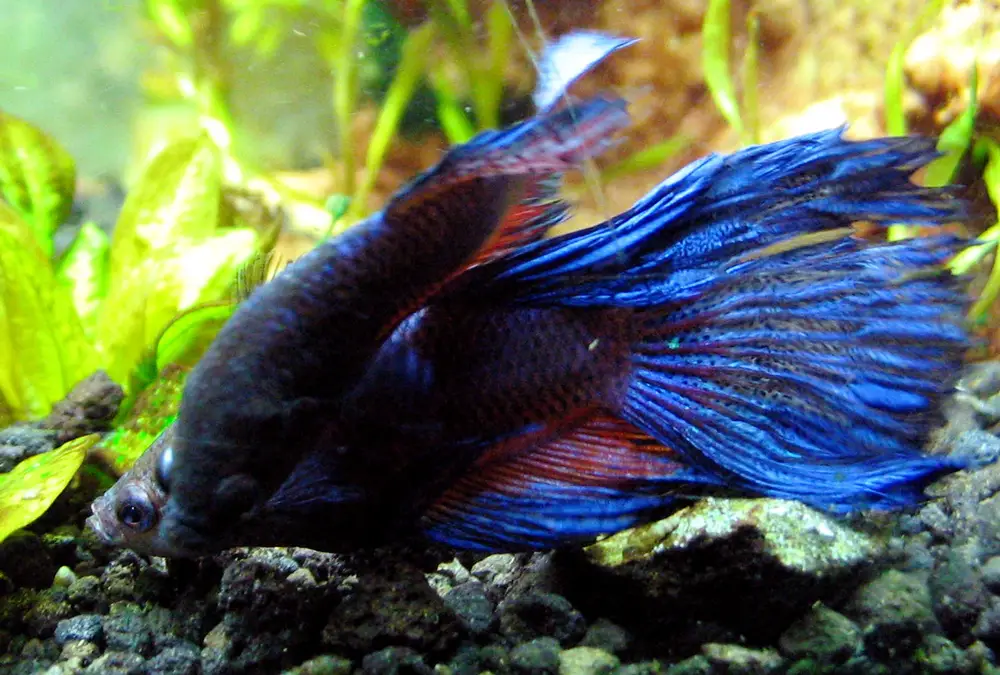
Two Female Bettas in the Same Tank
Female bettas aren’t as aggressive as their male counterparts. You can have more than one female in a tank as long as the tank is large enough to give them their own space.
Because every betta is different, occasionally, you might get an aggressive female. If one of your females starts picking on the other, you should consider removing the aggressive one from the tank and giving it a tank of its own.
When you have female bettas, you can add colorful fish in the tank with them without worrying about their tankmate’s coloration. You can also keep fish that are slightly larger than the female bettas. You don’t want to go too large, though. If the fish is big enough, it will try to eat your bettas.
A Male and a Female Betta
If you plan to keep one male and one female Betta fish together in the same tank, you will need a large, rectangular tank that is at least 30 gallons or more. You will also need plenty of plants and decorations that can be used as hiding spots for the female in case the male starts to get aggressive with her. The plants will help to break the betta’s line of sight.
If the male does attack your female, you should consider removing either the male or the female and giving it a tank of its own.
Best Tank Mates for Female Betta
Females aren’t as territorial as males and don’t mind when other fish might invade their space. Because of this laid back attitude, you can keep more of a variety of fish when you have female Bettas.
As always, each fish is different, and there is a possibility that you will get a more aggressive female than usual. Whatever species you do decide on as tankmates for your female Bettas should not have a reputation for nipping other fish’s fins.
Bottom-dwelling fish make perfect tankmates for your female Bettas. Since they won’t go near your Bettas, they won’t upset or annoy them.
- Pygmy Cory – Silver with a black stripe down its body
- Panda Cory – Silver with black spots on its body
- Clown Pleco – Sucker-mouth fish, brown with yellow stripes
- Clown Loach – Resembles a tiger with orange and black stripes
- Yoyo Loach – White with black stripes
Another good choice for tankmates is fast swimming and shoaling fish. If you have an aggressive female, they won’t single out any specific fish if they are shoaling together.
- Mosquito Rasbora – Silver with a black stripe down its body
- Penguin Tetra – Silver and white fish with bold black stripe
- Red Eye Tetra – Silver with black fins and reddish colored eye
- Blue Tetra – Blue colored with a silver belly
- Gold Tetra – Golden colored with black fins
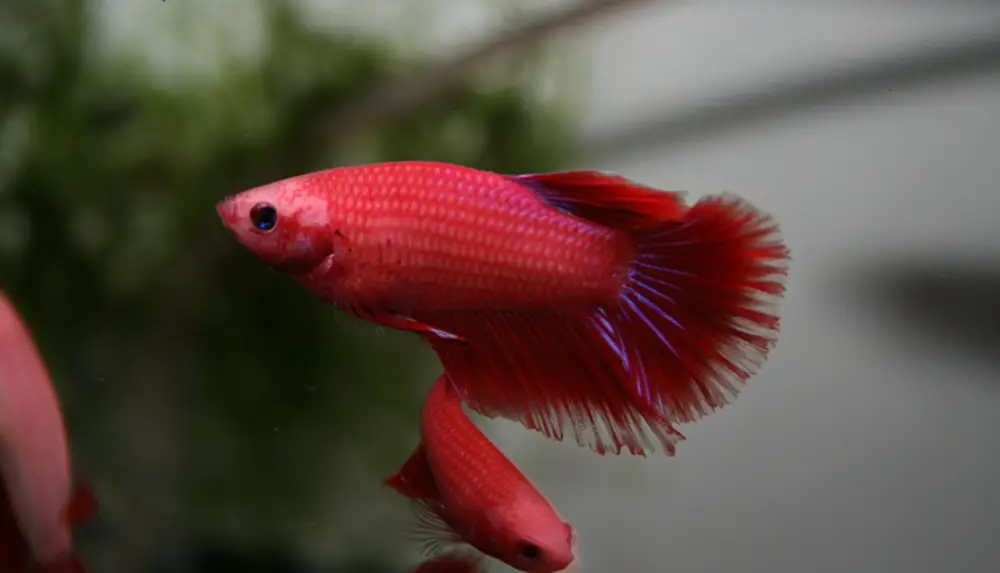
Best Tank Mates for Male Betta
When you have male Bettas, finding compatible tankmates can be challenging. You will need to choose tankmates carefully because the males are very territorial and aggressive. They will attack another male, and sometimes a female if they feel like the other fish is invading their space.
Another thing to consider is males do not like smaller, brightly colored fish. Fish that are red in color need to be avoided altogether because they will trigger your male Betta’s aggression. The male Bettas will also pick on slow swimming fish, as well. Avoid fish with long fins because your males will attack them and kill them.
Shoaling fish are good choices for tankmates for your male Bettas for the same reason as the females; the males won’t single out any specific fish to attack if they are shoaling together.
- Black-line Rasbora – Silver with a thin black line that ends with red tail
- Head and Tail Light Tetra – Reddish-orange color around the eye and on the tail
- Colombian Tetra – Silver and blue body with orange fins
- Green Neon Tetra – Silver with a fluorescent green stripe down its body
- Dawn Tetra – Golden colored with black spots on bottom fin and tail
You also want fish that will not trespass into your male Betta’s territory. Fish that occupy the bottom of the tank are perfect options.
- Candy Striped Pleco – Yellowish-brown with darker brown or black stripes
- Snowball Pleco – Black body with white polka dots
- Bristle Nose Pleco – Also known as Bushy Nose, black body with yellowish spots
- Albino Cory – Catfish with whitish-pink albino coloring
- Zebra Loach – Golden colored body with black zebra stripes
When you start to add vegetation and decorations to their tank, you increase the variety and complexity of their environment. Doing so will reduce the aggression your males show towards other fish since they won’t be in their line of sight all the time. All of the vegetation and decorations also provide plenty of places for the other fish to hide.
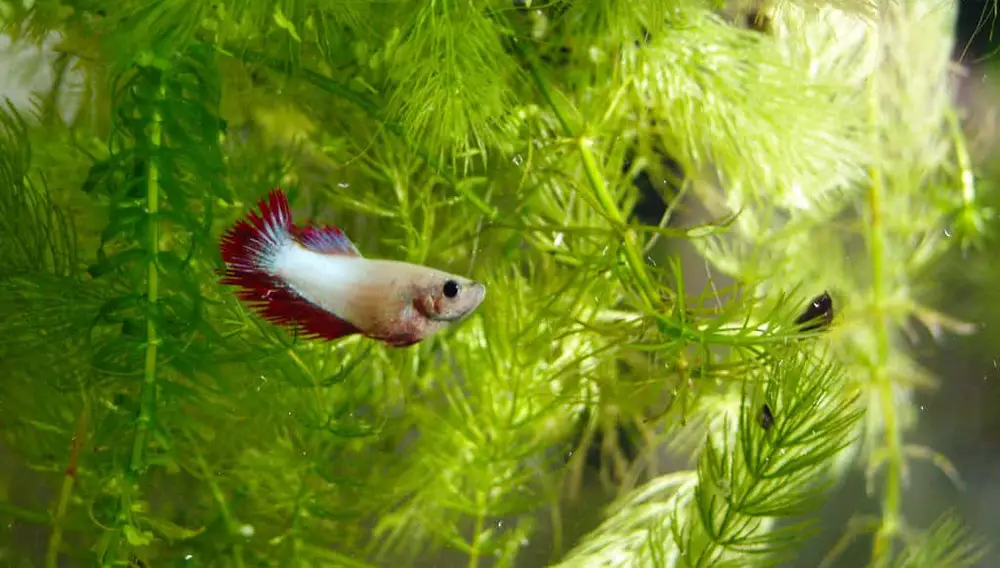
Betta Sorority Tank Mates
When you have a tank with five or more female Bettas, you have a Betta sorority, also called a Betta harem. If you plan to have a sorority of Bettas, you will need at least a 30-gallon tank. There should be a variety of decorations and plants, giving your Bettas adequate hiding spaces. They also need lots of room to swim freely.
Even though the females tend to be less aggressive than the male Bettas, each fish is different. Some females can be territorial and aggressive. You will need to choose wisely when considering tank mates for your female Bettas.
Some of the best tankmates for your sorority are:
- Guntea Loach – Grey belly with a black back
- Cory Catfish – Silver body with black spots
- Guppies – female are best, comes in a variety of colors,
- Black Neon Tetra – Golden body with black stripe and neon silver stripe
- Neon Tetra – Silver body with red strip below the neon green stripe
- Cherry Barbs – Red body, do not pair with male Bettas
Tank Mates in 5 Gallon Aquarium
Because a five-gallon tank is already so small, we don’t recommend adding tankmates with your Betta. A five-gallon tank is perfect for one Betta since Bettas are not social fish anyway. Instead, they keep to themselves, away from any other fish, regardless of how big or small the tank is.
For a five-gallon tank, you can add live plants to break up the monotony of the tank. Java Ferns and an Amazonian Sword Plant or two would be perfect for your Betta’s tank.
If you don’t want to bother with maintaining live plants, you can add a few artificial soft silk plants. Avoid heavier artificial plastic plants. They could possibly end up damaging your Betta’s finnage.
If you decide that you do want tankmates for your Betta, try ones that are non-fish, such as shrimp and snails.
Tank Mates in 10 Gallon Aquarium
If you want an aquarium with a Betta and other fish, then you should go with a ten-gallon or larger tank. Once again, you will need to set up the tank with plenty of vegetation and decorations to interrupt your Betta’s line of sight and provide hiding spaces for the other fish species. You can even add Bogwood logs to separate the areas of your tank and obstruct your Betta’s line of vision.
The most ideal tankmates for your Betta in a ten-gallon tank are bottom-dwelling fish, such as Catfish and small Loaches. Non-fish tankmates such as frogs, shrimp, and snails are a great addition to this size tank.
More Tank Mates That Can Live With Bettas
If you would like to do something a little different with your tank and not include other species of fish, you can try adding non-fish tankmates to your aquarium that are compatible with your Betta.
When choosing a non-fish tankmate, you want to choose ones that are too large for your Bettas to eat, but they still need to be small enough that they don’t cause any harm to any of your fish.
Below are the best snail tankmates for both your female and male Bettas
- Malaysian Trumpet Snail – This is a nocturnal species, which is perfect because they only get active when your Bettas are sleeping. They will also keep your tank clean. They will hide in the sediment during the day.
- Nerite Snail – These snails will hide in the sediment during the day as well. Because they require brackish water to breed in, you don’t have to worry about them overrunning the aquarium.
- Mystery Snail – Comes in a variety of colors, will clean the tank and eat left-over food. They also grow to a size big enough that you don’t have to worry about them becoming fish food.
If you want more variety and color with the added bonus of algae maintenance, you can add shrimp to your tank. Make sure you don’t pick the ones that are small enough for the Bettas to eat, instead pick the larger ones, and they’ll be safe. The adult Cherry Shrimp and the Ghost Shrimp make ideal tank mates for your Bettas.
If you want even more variety and a touch of exotic, you should consider adding an amphibian to your tank. The African Dwarf frog is a peaceful frog that will not bother your other fish and makes a great tankmate.
You might also be interested in: Types of Betta Fish – By Tail, Pattern and Color
Summary
As long as the tank is large enough and there is plenty of vegetation and decorations to break up the Betta’s line of sight, any of the fish we mentioned in this article would make great tankmates with your female Bettas and male Bettas unless specifically noted.
A five-gallon tank is the smallest you want to have with just one Betta, anything smaller is considered cruel.
A ten-gallon tank is the smallest size for keeping other fish with your Bettas.
Lastly, a 30-gallon community tank is the smallest size we recommend if you want to keep a sorority of Bettas.
After reading this article, we hope that you will have the confidence to keep Bettas in your aquarium.
